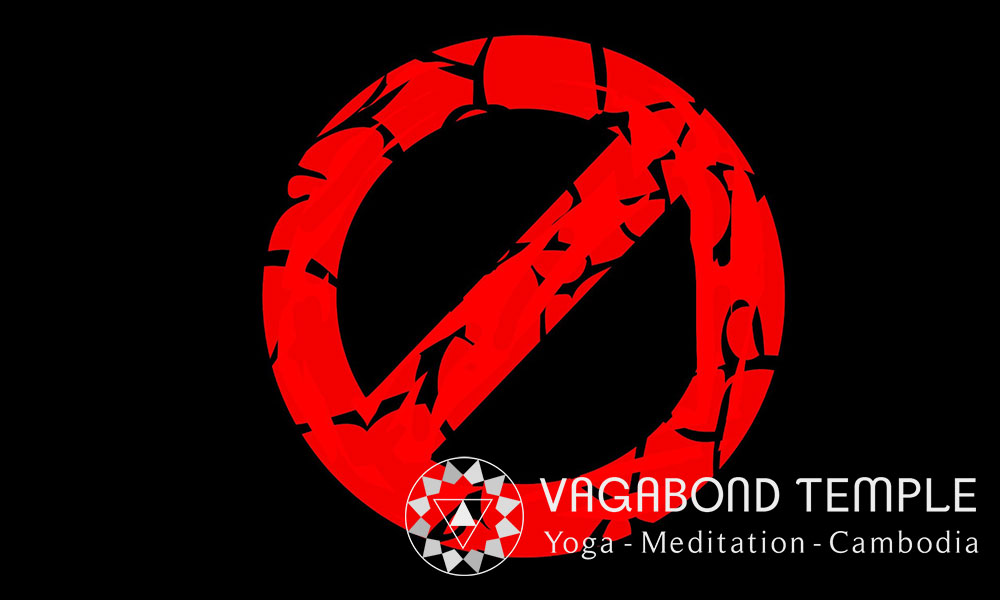Yoga Warning! Side effects may include spiritual awakening and a more harmonious society.

In modern society, people increasingly see Yoga as a form of exercise such as going to the gym or attending an aerobics class. There may be a vague sense that bending yourself into unusual positions has some kind spiritual benefit but that often seen as an add-on, rather than the primary purpose of the practice.
Of course practising Yoga can make your body stronger and better looking, and there is nothing wrong with that – it is beautiful to improve yourself. However there are a couple of problems here. Firstly we live in a hyper-consumer society, where our insecurities and desires are routinely exploited for profit. There is the danger that the Yoga can become just another “product”, marketed to us in the same way as cosmetics or clothing – which will provide a distorted picture of what it really is. Secondly, if we only focus on the physical benefits we will miss the much bigger picture. The sages of ancient India did not develop Yoga to get more followers on Instagram, it is a little deeper than that: Yoga is an ancient spiritual tradition aiming to cut to the heart of the problems we all face as human beings.
More Than Just The Postures!
In the Yoga Sutras of Pantanjali, one of the first textual accounts of the ancient practice of Yoga and seen by many as the foundation of Yogic practice, the Asanas (the postures practiced in Yoga sessions) are just one of the 8 “Limbs” of Yoga. The other 7 relate to meditate practices and attitudes for daily life and are covered by some of our other articles (see bottom of the page).
The Asanas were originally intended to strengthen the body in preparation for the deeper meditative practices. So if you are doing nothing but the Asanas it is like building a foundation but neglecting the rest of the building!
Lost In Translation
A important clue to the real significance of Yogic practice can be found if we look at the literal meaning of the term Sanskrit term “Hatha Yoga” (the style from which all modern practices derive). Sanskrit is a complex language with a single word having many potential translations. Many scholars translate “Yoga” as relating to the terms such as “Union”, “Joining”, “Bringing Together”. “Ha” can be translated as “Sun”, “Tha” as “Moon”.
The sun and the moon represent the opposite forces which make up all aspects of existence. Light / Dark; Good / Bad; Self / Other. Although opposite, each one cannot exist without the other (there is no light without the possibility of darkness). This is the meaning of the famous Yin Yang symbol found in books on Chinese philosophy and tattooed on to hippies!
So, translated this way “Hatha Yoga”, means something like “Union Of The Opposites”. The most fundamental of these opposites is Self vs Other. To the ordinary human being, there is an outside world, and a separate “I” having to somehow deal with it, often with traumatic results! You may be familiar with the Buddhist view that suffering is result of the false belief that we are an individual, separate from the rest of creation. The same idea that can be found in the Yogic tradition which teaches us how to resolve this problem and realise there is no separation.
It can all get a bit much trying to get your head around some these concepts, and if you were to experience the unity of yourself with all creation, you would not be able to describe it anyway! The spiritual path can simply be thought of as a way of learning to see things as they really are, not as you perceive them to be (or would like them to be!). We can also think of it as a way to bring us out of the limitations and frustrations of everyday life.
Finding Your Balance
So we can take a step back and understand how the concept of union of opposing forces applies to the practice of Yoga, and how it can benefit us.
The Sun represents the active “Yang” force assertive and powerful. The Moon relates to passive “Yin”, receptive, surrendering. This are both energies that we work with during spiritual practices and daily living: we may need strong effort to push us into leaving our comfort zones, but we also learn that many obstacles are to be overcome by surrender and acceptance. When these forces are imbalanced, we run into trouble: somebody practising Yoga in a purely active, Yang, way may push their body too far, or become overly competitive. Too much Yin and you may not even make it to class, preferring to stay in bed!
Imbalance brings many problems. A person who is too passive may have no motivation for living and develop a victim mentality – as if the world is against them and they are powerless to make any changes. On the opposite, active, extreme we find people like Donald Trump! Neither of these ends of the scale sound like particularly pleasant places to be.
In the Yogic tradition there is not a separation of the physical body and the mind, in fact they are interdependent – each being a manifestation of the other. The physical postures balance the left and right side of our bodies but are also directly working on the energy body which effects our emotions – this can be directly experienced in a Yoga class where different postures will trigger different emotional responses. In this way Hatha Yoga aims to create a balance between the passive and active sides of our being.
Society provides many examples of respected role models: the rich businessperson, the athlete, the super-model; perhaps also the simple farmer, or the reclusive artist. In the Yogic path, the ultimate role-model is the one who can dance between the opposites – bringing the passive and receptive energy into perfect balance. This is reflected in the image of Lord Shiva, one of the principle deities in Hinduism and considered the God of the Yogis, the cosmic dancer – often depicted as half male, half female. Back in the human realm we have characters like Ghandi, actively creating enormous social change, but through non-violent means.
Balanced Self, Balanced Society
Talking of social change, it is pretty clear that we leave in an imbalanced society. Life seems to be becoming more and more goal-oriented and competitive, which is causing enormous conflict and wreaking havoc on our environment. On the other hand there are many waking up to this and understanding the need for a more mindful way of life, realising that we must live in harmony with the world and each-other. By practising Yoga in its true form and bringing balance to your life you can be part of this change.
It is important to know what you are getting yourself in to. So if you are practising Yoga to get more likes on your Facebook photos, you may be inadvertently saving the world, and heading toward a spiritual awakening. Don’t say we haven’t warned you!
More Articles On Yoga
Niyama: Mastering Our Inner Space
Yama: Bringing Yoga Practice To Daily Life
Using Yoga To Prepare Our Minds And Bodies For Meditation



